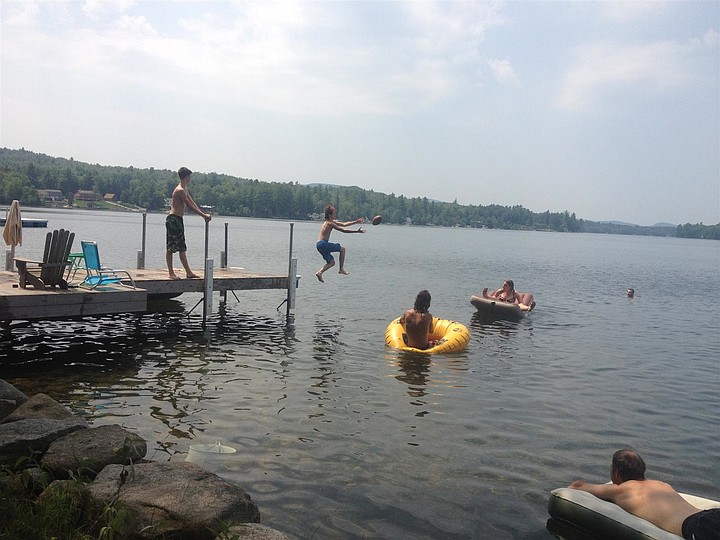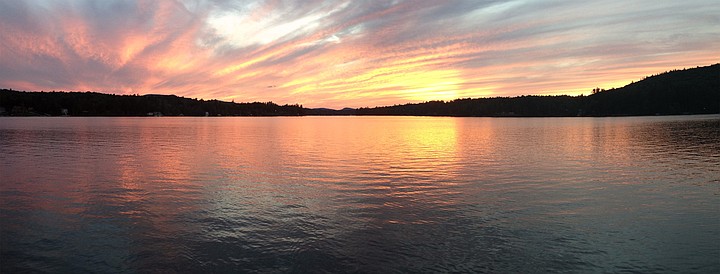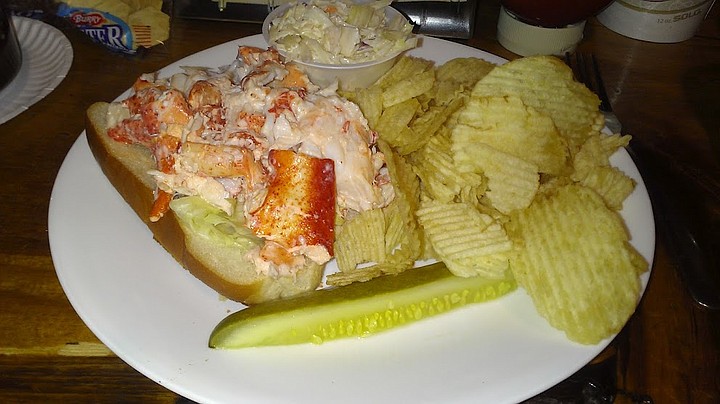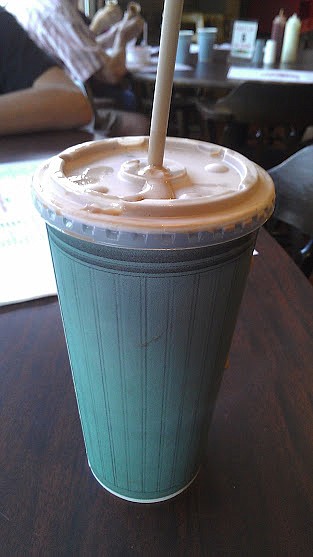 Facebook
Facebook
 X
X
 Instagram
Instagram
 TikTok
TikTok
 Youtube
Youtube

Summer is a great time to visit New Hampshire. In the spring, there are a lot of biting flies and it rains all the time. But once the warm, dry months of July and August set in, New Hampshire is at its best and most beautiful. It gets hot and muggy, especially compared to San Diego, but cooling off is almost never a problem for residents and vacationers.
That’s because New Hampshire has lakes: over nine hundred of them. That’s a lot of water for a state with a population roughly equal to the city of San Diego.

Lakes are central to life in NH during the summer. Swimming and fishing are hugely popular, and the tourism industry depends on vacationers who come to cool off and relax during the dog days. There's plenty of public access to the state’s lakes because shorelines remain undeveloped or held as parks for public swimming, so it’s not necessary to stay on lakefront property.
But it helps.
Spending a week or two in a lakeside cabin is the most direct way to experience a New England summer. Obviously, not everyone can own a lake house. That pleasure is reserved for the fortunate few. But the rest of us can rent one every now and again.

Big lakes, like Winnipesaukee or Winnisquam at the heart of the central New Hampshire Lakes Region, are ringed with cabins and homes. Smaller lakes, like Ossipee, Great East, Merrymeeting and Lovell , all within a half-hour’s drive of each other, may not be the summer homes of Presidential candidates and foreign dignitaries, but they’re no less refreshing when the weather turns hot. In fact, some of the smaller lakes offer more peace, quiet, and a chance to really get away from it all (see below).

Some cabins are antiquated, rustic shacks with no electricity; other people choose to erect multimillion-dollar homes that lack no convenience and could be occupied year-round. For a renter, the choices are wide open. The only limit is the cost, which can vary wildly: weekly rents can start at under $1,000 and range all the way up to $5,000 or more depending on the size of the camp, location, and the season. Finding a vacation rental has never been easier; a quick Google search turns up dozens of properties.
If you plan to rent a car, it’s smart to fly into Boston and drive to New Hampshire from there. Direct flights from San Diego to Boston can be hundreds of dollars cheaper than flights to the airport in New Hampshire. The drive to Wolfeboro, on the shores of Lake Winnipesaukee, from Boston is shorter than the drive to Los Angeles and guaranteed to be much more pleasant on any given day!

An entire week of sitting on the waterfront, soaking up the sun and the sweet, country air would be a vacation well-spent. Still, rural New Hampshire is worth exploring.
There's a lot of history to explore in the small towns that dot the landscape around the Lakes Region. Old farmhouses from the 18th and early 19th centuries provide a glimpse into a past where much of the state was clear-cut in an effort to establish working farms. With the exception of New Hampshire’s southwest territory, the soil proved difficult to farm, and agricultural interests quickly moved westward. But the old houses still stand, some of them restored to immaculate condition, many of them still occupied and proudly displaying the dates of their construction.
Much of the state is wooded, and the state parks offer hiking trails of varying difficulty. Serious hikers might consider venturing to the north and climbing in the White Mountains. New Hampshire is so small (the fourth-smallest state by land area) that it’s easy to go from the seacoast to the mountains and back in the course of day. The White Mountain range is part of the greater Appalachian range that runs down the East Coast, and the granite peaks that rise four to six thousand feet above sea level are diminutive in comparison to the mountains of the West, but they still offer spirited day hikes and crisp, mountain air.

Local cuisine offers little to dazzle the palates of city foodies, but when it does shine it shines very brightly. During the summer, seafood is the de facto culinary specialty. The lobster roll is perhaps the epitome of New England food. The perfect example is on plain white bread, either a slice or a hot dog bun, with a touch of lettuce and a generous portion of lightly dressed lobster salad. Always made from the true lobster of the Atlantic ocean, the meat should be tender and sweet and the dressing should only highlight the succulence of the lobster without burying it.

Another summer specialty in New England is fried seafood. Clams, scallops, shrimp, haddock, cod, and other white fish all grace the paper plates and plastic trays of humble-yet-delicious restaurants during the summer months. Soft-shell clams are a mainstay and, whether fried or steamed, eating a couple pounds of clams at one go is almost mandatory for anyone vacationing in New Hampshire.
The perfect drink to go with either of those meals is a “frappe,” which is what New Englanders – some might say correctly – call a milkshake. Ordering the latter will as often as not get you blended milk with no ice cream in it! Additionally, public water fountains are best referred to as “bubblers” – for the sake of fitting in.
For this San Diegan, the Granite State is a world apart. The old-school Yankee citizens, the freshwater lakes and the abundant greenery make it an amazing place to go to escape California for a little while, if only to fall in love with America's Finest City all over again for the sake of carne asada and hearing people pronounce “park the car” correctly.


Summer is a great time to visit New Hampshire. In the spring, there are a lot of biting flies and it rains all the time. But once the warm, dry months of July and August set in, New Hampshire is at its best and most beautiful. It gets hot and muggy, especially compared to San Diego, but cooling off is almost never a problem for residents and vacationers.
That’s because New Hampshire has lakes: over nine hundred of them. That’s a lot of water for a state with a population roughly equal to the city of San Diego.

Lakes are central to life in NH during the summer. Swimming and fishing are hugely popular, and the tourism industry depends on vacationers who come to cool off and relax during the dog days. There's plenty of public access to the state’s lakes because shorelines remain undeveloped or held as parks for public swimming, so it’s not necessary to stay on lakefront property.
But it helps.
Spending a week or two in a lakeside cabin is the most direct way to experience a New England summer. Obviously, not everyone can own a lake house. That pleasure is reserved for the fortunate few. But the rest of us can rent one every now and again.

Big lakes, like Winnipesaukee or Winnisquam at the heart of the central New Hampshire Lakes Region, are ringed with cabins and homes. Smaller lakes, like Ossipee, Great East, Merrymeeting and Lovell , all within a half-hour’s drive of each other, may not be the summer homes of Presidential candidates and foreign dignitaries, but they’re no less refreshing when the weather turns hot. In fact, some of the smaller lakes offer more peace, quiet, and a chance to really get away from it all (see below).

Some cabins are antiquated, rustic shacks with no electricity; other people choose to erect multimillion-dollar homes that lack no convenience and could be occupied year-round. For a renter, the choices are wide open. The only limit is the cost, which can vary wildly: weekly rents can start at under $1,000 and range all the way up to $5,000 or more depending on the size of the camp, location, and the season. Finding a vacation rental has never been easier; a quick Google search turns up dozens of properties.
If you plan to rent a car, it’s smart to fly into Boston and drive to New Hampshire from there. Direct flights from San Diego to Boston can be hundreds of dollars cheaper than flights to the airport in New Hampshire. The drive to Wolfeboro, on the shores of Lake Winnipesaukee, from Boston is shorter than the drive to Los Angeles and guaranteed to be much more pleasant on any given day!

An entire week of sitting on the waterfront, soaking up the sun and the sweet, country air would be a vacation well-spent. Still, rural New Hampshire is worth exploring.
There's a lot of history to explore in the small towns that dot the landscape around the Lakes Region. Old farmhouses from the 18th and early 19th centuries provide a glimpse into a past where much of the state was clear-cut in an effort to establish working farms. With the exception of New Hampshire’s southwest territory, the soil proved difficult to farm, and agricultural interests quickly moved westward. But the old houses still stand, some of them restored to immaculate condition, many of them still occupied and proudly displaying the dates of their construction.
Much of the state is wooded, and the state parks offer hiking trails of varying difficulty. Serious hikers might consider venturing to the north and climbing in the White Mountains. New Hampshire is so small (the fourth-smallest state by land area) that it’s easy to go from the seacoast to the mountains and back in the course of day. The White Mountain range is part of the greater Appalachian range that runs down the East Coast, and the granite peaks that rise four to six thousand feet above sea level are diminutive in comparison to the mountains of the West, but they still offer spirited day hikes and crisp, mountain air.

Local cuisine offers little to dazzle the palates of city foodies, but when it does shine it shines very brightly. During the summer, seafood is the de facto culinary specialty. The lobster roll is perhaps the epitome of New England food. The perfect example is on plain white bread, either a slice or a hot dog bun, with a touch of lettuce and a generous portion of lightly dressed lobster salad. Always made from the true lobster of the Atlantic ocean, the meat should be tender and sweet and the dressing should only highlight the succulence of the lobster without burying it.

Another summer specialty in New England is fried seafood. Clams, scallops, shrimp, haddock, cod, and other white fish all grace the paper plates and plastic trays of humble-yet-delicious restaurants during the summer months. Soft-shell clams are a mainstay and, whether fried or steamed, eating a couple pounds of clams at one go is almost mandatory for anyone vacationing in New Hampshire.
The perfect drink to go with either of those meals is a “frappe,” which is what New Englanders – some might say correctly – call a milkshake. Ordering the latter will as often as not get you blended milk with no ice cream in it! Additionally, public water fountains are best referred to as “bubblers” – for the sake of fitting in.
For this San Diegan, the Granite State is a world apart. The old-school Yankee citizens, the freshwater lakes and the abundant greenery make it an amazing place to go to escape California for a little while, if only to fall in love with America's Finest City all over again for the sake of carne asada and hearing people pronounce “park the car” correctly.